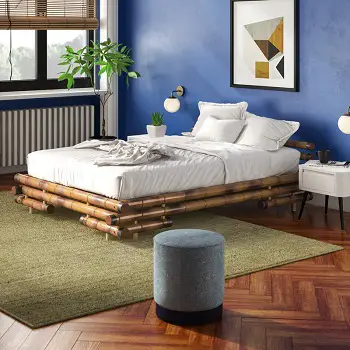Bamboo is a tropical plant that has gained popularity around the world due to its many uses and durability.
It is a common material option for landscaping, home decorations, furniture, construction, kitchen essentials, clothing, and more.
Mainly, these plants are less vulnerable to diseases caused by bugs and other insects but that doesn’t mean that bamboos are immune from them.
In general, a bamboo plant does attract bugs because it contains rich nutrients that insects need to live and thrive. Bamboo is abundant in starch and carbohydrates which makes it a potential food supply and dwelling place for mites, aphids, mealybugs, and other insects.
The good news is, with proper care and monitoring, the possibility of these insects wreaking havoc in your bamboo plant can be reduced or avoided altogether.
Although the threats are mostly not fatal, it is still important to avoid the infestation to allow the bamboo plant to grow to its full potential.
Here are the seven easy ways on how you can stop the bugs from eating your bamboo plants:
1. Prevention
Checking your bamboo plant regularly for any changes would help you identify if there’s an infestation early on.
Unusual changes such as premature leaf drop, prominent discoloration on leaves, and falling powdery dust are important indications that your bamboo plant might be in trouble.
If you suspect an infestation on one of your bamboo plants, then separate it right away to prevent the spread of the disease to the other plants.
2. Pressure Wash
Power wash your bamboo using a hose to remove insects, molds, and other particles that can potentially harm the plant.
Focus on commonly infected areas such as the underside of your bamboo leaves. It is recommended to pressure wash your infected bamboo plant multiple times in one week to rid of the insects that may dwell and feed on the bamboo.
3. Spray with Soap
Treating the bamboo with soap is an effective way to stop the bugs from eating your bamboo plants.
Try mixing a tablespoon of detergent into a gallon of water, then place the solution in a spray bottle for easy application. Spray the solution to the bamboo every two weeks to eliminate the insects.
4. Spray with Vinegar, Vegetable Oil, Baking Soda, and Water
If you’re looking for a natural alternative to eliminate the insects, then you can create a solution using the abovementioned ingredients.
Mix a teaspoon of baking soda and a tablespoon of vegetable oil in a 1/4 cup vinegar and one cup of water to create the solution.
Place the solution in the spray bottle and apply it on the bamboo every week until the insects are eliminated.
5. Spray with Horticultural Oil
For severe infestation, spray the bamboo with a mixture of water and horticultural oil.
These oils are specially formulated to control insects and treat the plant for other possible existing diseases.
It can kill pests instantly, but it is recommended to apply this oil not more than once in one day as it may damage the bamboo.
6. Chop the Bamboo
If the infestation seems to be out of control even after applying the measures mentioned above, then you might want to consider trimming down the leaves and stalks of your bamboo.
Mites are one of the most common culprits when it comes to bamboo infestations and these insects are difficult to eliminate since they are very tiny.
They normally dwell under the leaves and trimming the foliage and stalks altogether would be the most ideal solution if the problem persists.
Fortunately, bamboos can grow quickly, so you can expect to have a healthier plant once all the contaminated leaves and stalks are removed.
7. Apply Glyphosate or Imazapyr Herbicide
Glyphosate or Imazapyr Herbicide are toxic chemicals and the last resort to ultimately end the infestation in your bamboo plant.
If you really must go this route to solve the problem, make sure to follow all the safety precautions or ask an expert who is trained in this method.
Prior to application, the bamboo needs to be chopped first to ground level and then wait for the new shoots to grow at least 3 feet tall.
With your protective gears, spray the chemical to the newly expanded bamboo leaves by following the directions in the chemical’s packaging.
This is the most drastic method, and it is highly recommended to try the easier methods first before you consider applying the chemical.
Summary
By now, you should be well aware that bamboo plants attract bugs. Luckily, there are a number of things you can do to solve the problem.
It’s a good idea to be proactive and start with the preventive methods to make sure your plants grow strong and healthy.
Bamboo Group is a collaboration of individuals who love the world’s most sustainable and eco-friendly natural material. We believe every home can benefit from the natural colors and patterns of bamboo. We’re excited to see bamboo grow in popularity and get the recognition it deserves. Years of experience growing bamboo plants have taught us a lot we want to share with the world.



